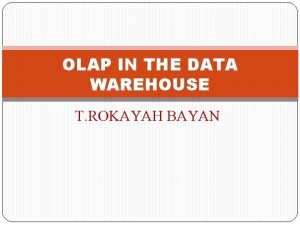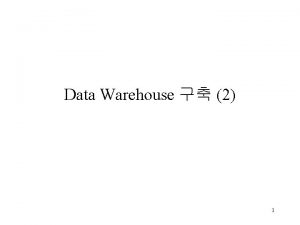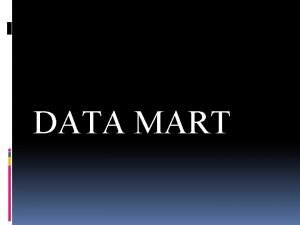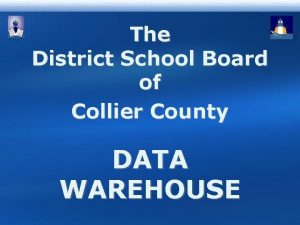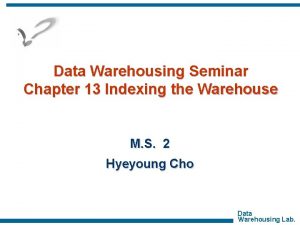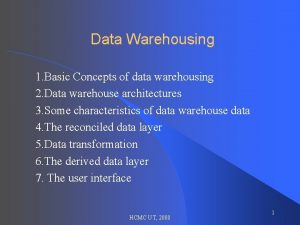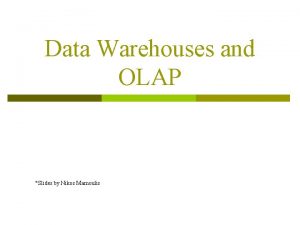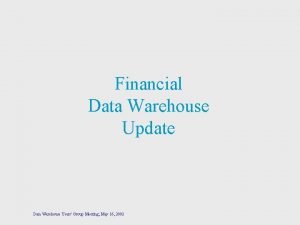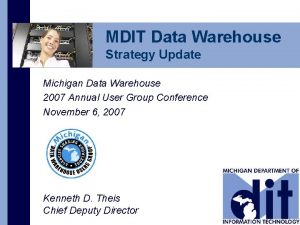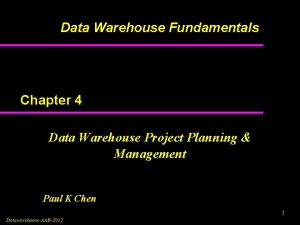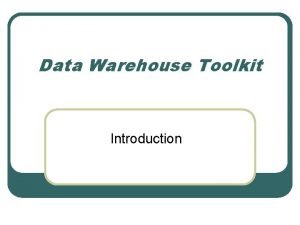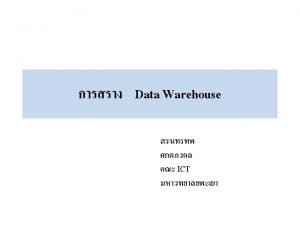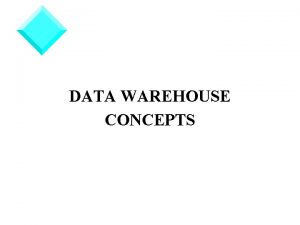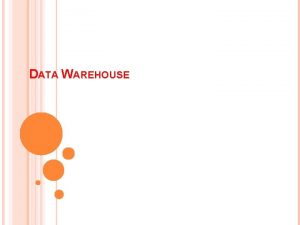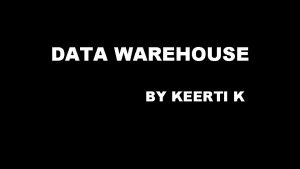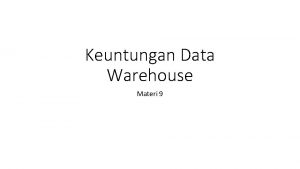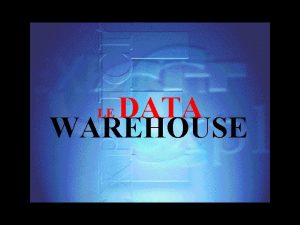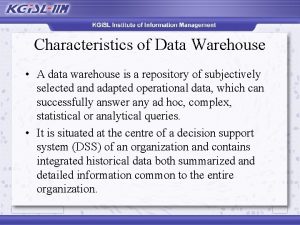Data Warehouse 2 1 Drill across process of































- Slides: 31

Data Warehouse 구축 (2) 1

Drill across • process of linking tow or more fact tables at the same granularity – dimension table공유 2

Star Schema : Time dimension • 시간차원의 중요성 – 시간차원이 없는 질의는 meaningless! • What are the sales volumes for all products available in store 52? • “for what period of time” – Time의 속성 • day of week, week of month, work day, weekend, holiday, season, fiscal period 3

Star Schema : Space dimension • Space차원이 있는 질의 – Marketing 정책 수립에 유용한 분석 보고서 작성 – “What is the average driving distance for all customers who made a purchase at store 52 during the Christmas holiday season? ” – “What is the average income and family size of the neighborhoods where my customers exists? ” • effectively expand analysis domain • Space 차원의 속성 – 위/경도, street address, street block, city quadrant, zip code, street, city, country, state, – demographic information • household income, education, family size, home value, etc • customer address ~ store(school)간 driving time 4

Star Schema : Space dimension • Spatial industry – petroleum, telecommunications, government agencies • 질의 예 – “What is all those customers who bought from stores 1 & 2 during the Christmas holiday season? ” • (result) All customers who drove 3 minutes or less to a store in Tampa during holiday season – “See the market for all stores in the surrounding area presented in concentric rings of 1, 2, & 3 miles” – “See total potential customers who drive time to each of your store in the Tampa area is 4, 8, or 12 minutes 5


Spatial dimension이 추가된 Star Schema Time Dimension customer_id customer_code customer_name address 1 address 2 city state zip telephone life_stamp * customer_geo_code date_id customer_id product_id store_id customer_geo_id item_price item_qty item_cost customer_geo_id customer_geo_code zip_code census_track block_group country state avg_income avg_house_size avg_age. . . product_id product_code description unit_price unit_cost selling_unit stocking_unit life_stamp. . . 7

Star Schema : Space dimension • Target Mailing 에 응용 예 – for tuning AD. expenditure • targeting upper-middle class, middle-aged males • “What was our total sales revenue from customers who bought from store 52 during Christmas season and who live in neighborhood earning an average of $50, 000 per year and are more than 30 years old? ” 8

Star Schema : Space dimension • For the success of spatial data in DW – the effectiveness of the database extensions for spatial data types – providing specific applications that make it easy to include spatial data as a natural part of user application – Spatial data의 활용 9

Star Schema : Extensibility • 확장성 – add new dimension at any time, as long as you are careful to preserve the original grain – 기존 프로그램 그대로 운용 가능 • Causal dimension – advisory dimension that should not change the fundamental grain of a table • 어떤 event가 일어나게 된 이유를 설명 • promotion, store condition – “Was my promotion profitable? ” 10

Star Schema : Extensibility • Building the fact table at a granular level – 만약, 주단위로 요약된 fact table의 경우, monthly data로 확장할 수는 없다. 11

New causal dimension Causal_key Condition_name Price_treatment_type Price_discount Ad_type Ad_media_name Ad_size Display_type Display_provider Display_size 12

1. Adding new unanticipated facts • as long as they are consistent with the fundamental grain of the existing fact table 2. Adding completely new dimensions (ex. causal dimension) • as long as there is a single value of that dimension defined for each existing fact record 3. Adding new, unanticipated dimensional attributes 4. Breaking existing dimension records down to a lower level of granularity from a certain point in time forward. (minidimension)13

Star Schema : Helper • In Health. Care billing – grain : individual line item on a doctor bill – 한 환자가 여러 개의 진단명을 가질 수 있음. – choose one value (“primary” diagnosis) and omit the other values • Diagnosis data의 유용성이 떨어짐 – create a fixed number of additional Diagnosis dimension slots in the fact table key • Helper Table – weighting factor : 한 grain을 형성하는 각 요소의 중요도 할당 • 예) 3개의 진단명이 있는 경우, 각 weighting factor는 1/3 14

Star Schema : Helper 15

Star Schema : Factless Fact Tables • 단지, dimension table과 link되는 multi-part key만을 가지고 있음 • 유형 I : table that record event (event-tracking table) – 예) fact table for recording student attendance on a daily basis at a college • • • grain : individual student attendance event “Which classes were the most heavily attended? ” “Which classes were the most consistently attended? ” “Which teachers taught the most students? ” “Which teachers taught classes in facilities belonging to other departments? ” “What was the average total walking distance of a student in a given day? ” 16

Star Schema : Factless Fact Tables 17

Star Schema : Factless Fact Tables • 유형 II : coverage table – 일어나지 않은 사건에 대한 질의를 수행 • “Which products were on promotion that didn’t sell? ” – fact table의 내용이 sparse할 때 사용 – 예) coverage table for each product in each store that is on promotion in each time period (9609) 18

Star Schema : Factless Fact Tables 19

Star Schema : Slowly Changing Dimension • Example – 품목 설명이 종종 바뀌는 ‘품목’ 차원 테이블 • 처리 방법 – Overwriting • 변경된 dimension 속성의 과거 이력을 보존하지 못함. • 그래서, 이전 value가 중요하지 않은 경우에 사용 – Creating Another Dimension Record – Creating Current Value Field 20

Star Schema : Slowly Changing Dimension • Creating Another Dimension Record – generalize the key to changed dimension • 예) primary key + version digit • product dimension의 경우, SKU#+01, SKU#+02 – fact table의 레코드들을 dimension attribute의 history에 따라 partition이 가능 – 과거 이력을 수직적으로 보존 – 단점 • dimension key의 generalization • dimension table의 크기(레코드 수) 증가 • Creating a Current Value Field – “current value” 필드를 추가 – 과거 이력을 수평적으로 보존 21

Star Schema : Slowly Changing Dimension *예) Pkg_type변동 glued box => pasted box SKU#-01 => SKU#-02 22

Star Schema : Big Dimension • “Big” dimension – millions or tens of millions records • 예) customer dimension – 개개인(고객)의 정보를 기록 – 압축, 요약이 힘들고, 다른 차원 테이블에 비해 변동이 심함. • Mini. Dimension의 생성 – 어느 정도 static한 dimension과 계속적으로 변하는 dimension을 분리 – 예) customer dimension의 경우에 demographic minidimension • 계속 변화하는 demographic measure (income, purchase_behavior)가 일정 간 격을 가지는 구획값으로 변형 • demographic dimension attribute의 모든 가능한 값의 조합을 결정하여 키값 을 생성 23

Demographic Dimension Sales Fact time_key demographics_key customer_key product_key promotion_key sales_units sales_dollars demographics_key age_level income_level marital_status sex purchase_behavior Customer Dimension customer_key first_name last_name street_address city state zip demographics_key 24

Star Schema : Mini. Dimension • Mini. Dimension – minimize the joins necessary thought the fact table when you want to retrieve spatial data for customers without fact aggregation Big Dimension 25

Star Schema : Mini. Dimension • Advantages – support frequent snapshotting of customer profiles with no increase in data storage or data complexity as you increase the number of snapshots – demographic dimension itself cannot be allowed to grow too large • Disadvantages – browsing performance 저하 • demographics data can only be browsed along with the more constant customer data by liinking through the fact table – if fact table is empty, (아무런 event가 발생하지 않음) • cannot link the demographics to the customer • dummy sales event 삽입 26

Star Schema : Voyage • 여행관련 분석질의 – How many trips are there in a typical overall tickets? – Between which trip city pairs do we have the most customer satisfaction problem? – cf) telephone cable 27

Star Schema 예 : Voyage 28

Star Schema 예 : Insurance • Transaction, Claim Processing 29

Star Schema : 인적자원 관리 30

Star Schema : 인적자원 관리 • 분석질의 – report summary statuses of the entire employee base on a regular (monthly) basis • # of employees, total salary paid during the month • cumulative salary paid this year • cumulative vacation days taken, vacation days accrued, number of new hires, # of promotions – profile the employee population at any precise instant in time • how many employees we have • what their detailed profiles were on that date – monitoring every action taken on a given employee • transaction sequence/time 31
 What does olap stand for
What does olap stand for Drill across
Drill across What is kdd process in data mining
What is kdd process in data mining Contoh data mart
Contoh data mart Data warehouse elements
Data warehouse elements Contoh data mart pada departemen penjualan
Contoh data mart pada departemen penjualan Difference between operational and informational data
Difference between operational and informational data Perbedaan data warehouse dan data mining
Perbedaan data warehouse dan data mining Perbedaan data warehouse dan data mining
Perbedaan data warehouse dan data mining Olap data warehouse
Olap data warehouse What is data acquisition in data warehouse
What is data acquisition in data warehouse Data warehouse vs data mart
Data warehouse vs data mart Olap server architecture in data warehouse
Olap server architecture in data warehouse Data warehouse dan data mining
Data warehouse dan data mining Analitical cubism
Analitical cubism Visio sql
Visio sql Collier county data warehouse
Collier county data warehouse Parallel data warehouse sql server 2012
Parallel data warehouse sql server 2012 Northwind data warehouse
Northwind data warehouse Epm data warehouse
Epm data warehouse Olam in data warehouse
Olam in data warehouse Bislr medical groups
Bislr medical groups Front room vs backroom data warehousing
Front room vs backroom data warehousing Data warehouse requirements gathering
Data warehouse requirements gathering Azure sql data warehouse
Azure sql data warehouse Sqlhammer
Sqlhammer Data warehouse empresarial
Data warehouse empresarial Data warehouse seminar
Data warehouse seminar Query driven approach in data warehouse
Query driven approach in data warehouse Data warehouse and olap technology
Data warehouse and olap technology Data warehouse basic concepts
Data warehouse basic concepts Slide data warehouse
Slide data warehouse
